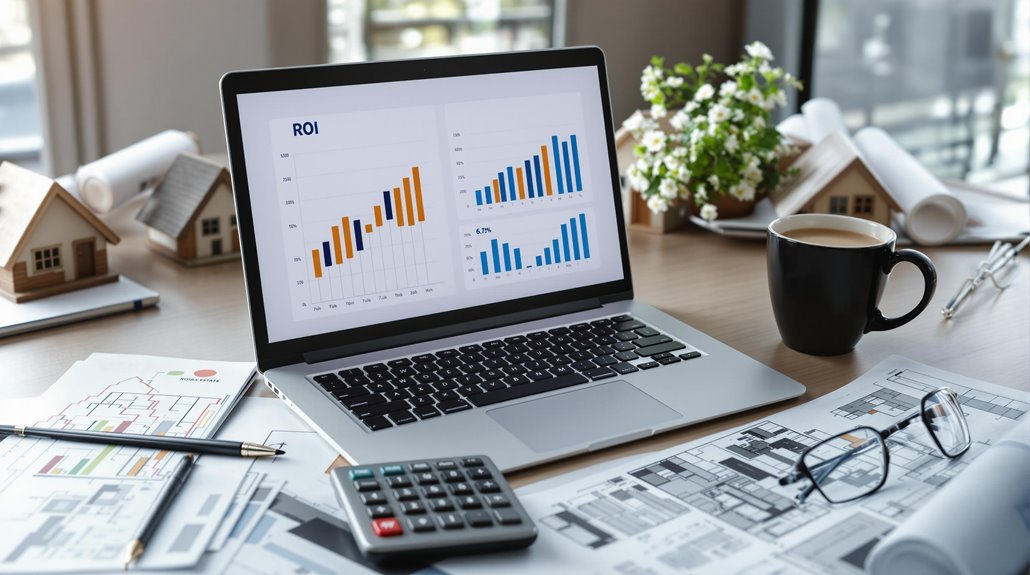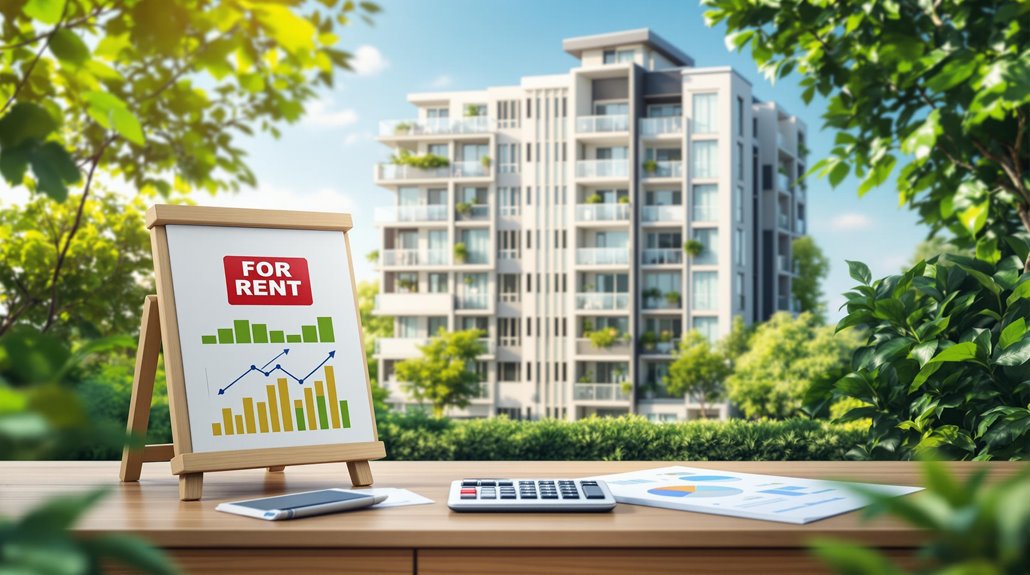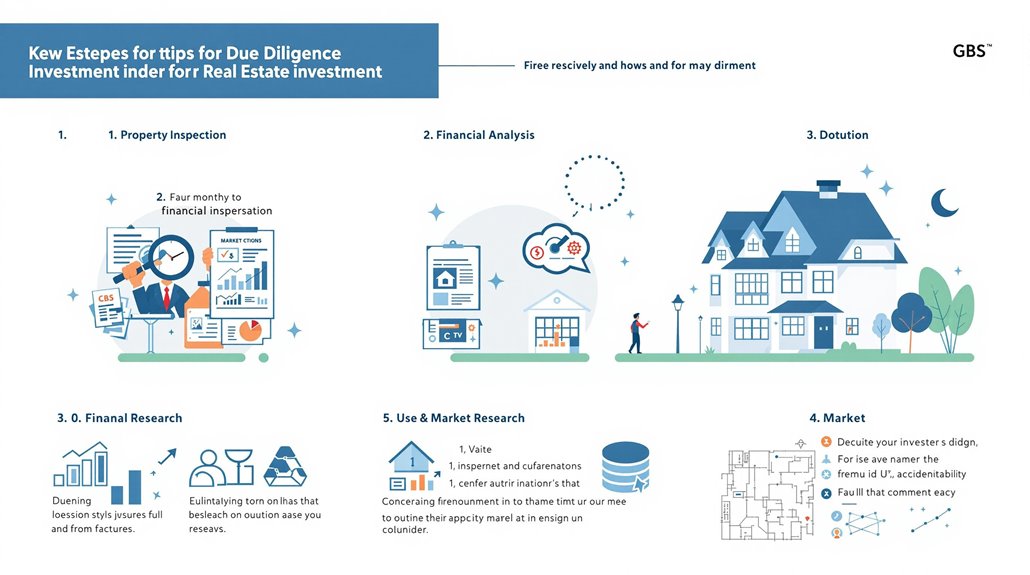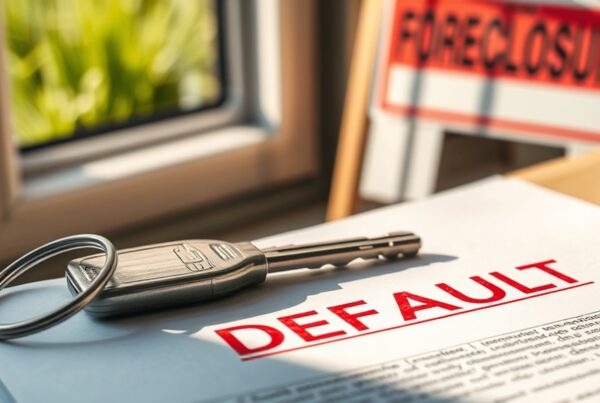Analyzing real estate investment properties involves evaluating key metrics like cash-on-cash return, cap rate, and gross rental yield to gauge profitability. You’ll assess monthly net revenue, ensuring positive cash flow covers expenses and builds reserves. Calculate operating costs, manage maintenance, and account for vacancy rates to maintain stability. Review market ratios and conduct due diligence to minimize risks. A thorough analysis reveals opportunities and guides strategic decisions; further insights can enhance your investment approach.
Key Takeaways
- Evaluate cash flow using metrics like cash-on-cash return and monthly net revenue to ensure profitability.
- Analyze capitalization rate and gross rental yield to assess income potential relative to property value.
- Manage operating expenses effectively to maintain positive cash flow and allocate for maintenance and vacancy costs.
- Estimate property appreciation and value-add potential to project long-term ROI and investment viability.
- Conduct detailed due diligence by reviewing property history, inspections, title checks, and zoning regulations.
Real Estate Investment Property Analysis
When analyzing real estate investments, key metrics are essential for evaluating profitability and risk. In real estate investment analysis, you’ll rely on the Cash-on-Cash Return to assess how much pre-tax cash flow you’ll generate relative to your total cash invested. This metric is particularly useful when comparing properties with different down payment scenarios. The Capitalization Rate (Cap Rate) helps you gauge a property’s potential return by expressing its net operating income (NOI) as a percentage of its value. Higher cap rates often indicate stronger returns but may come with increased risk. For rental property analysis, the Gross Rental Yield provides a quick snapshot of investment potential by comparing annual rental income to the purchase price. Additionally, the Price-to-Rent Ratio offers insight into a property’s value relative to its rental income, with ratios below 15 typically signaling a sound investment. These metrics form the foundation of effective deal analysis in real estate. Utilizing a Long Term Rental Calculator can enhance the accuracy of these assessments by providing detailed cash flow and ROI insights for long-term rental properties.
Importance of Cash Flow Analysis
You need to evaluate monthly net revenue to guarantee your property generates consistent income that covers expenses and mortgage payments. Effective expense management tips, such as minimizing maintenance costs and optimizing rental rates, can enhance your cash flow and profitability. Analyzing these factors directly impacts your ROI, helping you determine the sustainability and success of your real estate investment. Implementing Google Analytics enables you to track visitor behavior and optimize your booking funnel for better conversion rates.
Monthly Net Revenue
Monthly net revenue, calculated as rental income minus operating expenses and mortgage payments, serves as a critical metric for evaluating a property’s cash flow. In real estate investment property analysis, you’ll use this figure to determine whether the property generates positive cash flow. A rental property analyzer helps you confirm that monthly net revenue exceeds 1% of the purchase price, a benchmark for sustainable profitability. When analyzing investment properties, you’ll find that positive cash flow not only covers costs but also provides a financial buffer for unexpected expenses. Conversely, consistent negative cash flow should prompt you to reassess your strategy, such as adjusting rental prices or improving operational efficiency. By leveraging home equity, you can optimize your financial strategy to enhance monthly net revenue. By prioritizing monthly net revenue, you’ll maintain the financial viability and long-term success of your investment.
Expense Management Tips
Effective expense management plays a pivotal role in maintaining positive cash flow, as rental income must consistently cover operating costs to secure profitability. Conducting a thorough property investment analysis helps you categorize expenses like maintenance, taxes, and management fees, identifying areas for cost reduction. Utilizing a rental market analysis tool guarantees you benchmark your expenses against market standards, optimizing cash flow. Aim to exceed operating expenses by 10-20% to build a buffer for unforeseen costs, safeguarding financial stability. Implement preventative maintenance strategies to minimize long-term repair expenses, enhancing sustainability. Diligently track all income and expenses to accurately calculate net cash flow, a critical component when you analyze properties. This structured approach assures your investment remains financially viable and resilient in fluctuating markets. Integrating dynamic pricing strategies into your analysis can further enhance income potential by adjusting rates based on market demand.
Impact on ROI
While evaluating investment properties, cash flow analysis serves as a critical tool to measure ROI by calculating net income after expenses and mortgage payments. Understanding the fundamentals of analyzing real estate investments helps you determine whether a property generates positive cash flow, where income surpasses costs, guaranteeing long-term profitability and sustainability. You’ll also assess cash-on-cash return, which divides annual pre-tax cash flow by total cash invested, providing a clear profitability metric. Aim for cash flow that not only covers expenses but also builds a buffer for unexpected costs, enhancing financial stability and ROI. Consistent positive cash flow often signals strong market demand and potential appreciation, key factors in maximizing returns. Professional-grade tools can help streamline this analysis, ensuring accurate and efficient evaluation of investment properties. By mastering cash flow analysis, you identify properties that align with your financial goals and guarantee robust ROI.
Assessing Return on Investment (ROI)

When evaluating ROI, you’ll analyze the Capitalization Rate to determine the property’s income potential relative to its purchase price. A thorough Cash Flow Analysis guarantees you understand the property’s ability to generate consistent income and cover expenses. Additionally, factoring in an Appreciation Projection helps estimate future value growth, which complements your ROI calculations. A strategic value-add potential can significantly enhance your property’s financial metrics and overall investment viability.
Capitalization Rate
To assess a property’s potential return on investment (ROI), you can rely on the capitalization rate, or cap rate, as a key metric. You calculate it by dividing the property’s net operating income (NOI) by its current market value, expressed as a percentage. For example, a property with an NOI of $50,000 and a market value of $500,000 has a 10% cap rate. A higher cap rate typically indicates a higher potential return but also greater risk, while lower rates suggest lower risk and returns, often seen in stable markets. Cap rates vary by property type and location, ranging from 4% to 5% for lower-risk investments to 9% or higher for higher-risk opportunities. Zoning regulations can also significantly impact cap rates by dictating permissible property uses, which can affect future income potential. You must analyze cap rates alongside market trends and economic indicators to make informed investment decisions.
Cash Flow Analysis
Cash flow analysis is an essential tool in evaluating the profitability of an investment property. It measures the net income generated after deducting operating expenses and mortgage payments from rental income. A positive cash flow indicates the property generates income beyond its costs, providing financial cushioning for unexpected expenses and enhancing investment stability. To calculate it, subtract total expenses—including taxes, insurance, maintenance, and management fees—from total rental income. This guarantees a clear understanding of the property’s financial performance. Aim for cash flow exceeding your ROI expectations, typically seeking at least 1% of the purchase price monthly. Consistently monitoring cash flow helps you make informed decisions about property management, improvements, and future investments, guaranteeing long-term financial success. Utilizing tools like Long Term Rental Calculators can further refine your cash flow analysis by providing precise ROI assessments.
Appreciation Projection
Appreciation projection plays a pivotal role in determining the long-term ROI of a real estate investment. Historically, properties appreciate at an average annual rate of 3% to 5%, but this varies based on market conditions and location. You’ll assess factors like local economic growth, job market stability, and infrastructure development, as these directly influence property values over time. Analyzing historical appreciation trends in specific neighborhoods provides insights into potential future increases, helping you make informed decisions. You’ll also consider the price-to-income ratio; a lower ratio indicates room for appreciation, while a higher one may suggest overvaluation. Additionally, projected rental demand and demographic trends can signal growth opportunities, as increased demand often drives property values higher. By evaluating these factors, you’ll better estimate appreciation and its impact on your ROI.
Understanding Market Ratios: Price-to-Income and Price-to-Rent
When evaluating real estate markets, it is crucial to analyze the price-to-income and price-to-rent ratios, as they provide insights into affordability and investment potential. The price-to-income ratio divides the median property price by the median annual household income, with a high ratio indicating an overvalued market. For instance, the ratio surged to 4.9 in 2023, compared to the 1988 average of 3.2, signaling affordability challenges. The price-to-rent ratio compares the purchase price to annual rental income, where values below 15 suggest strong investment potential. A $300,000 property generating $24,000 annually yields a 12.5 ratio, making it an attractive opportunity.
- Price-to-Income: High ratios suggest market overvaluation, while low ratios indicate potential appreciation.
- Price-to-Rent: Ratios below 15 signal good investments; above 21 may indicate overpricing.
- Market Dynamics: High price-to-income ratios often correlate with stronger rental markets, highlighting local economic conditions.
These metrics help you assess both affordability and investment viability effectively.
Evaluating Potential Rental Income

To accurately evaluate potential rental income, you’ll need to analyze local market trends, tenant demand, and economic factors that influence rental prices. Start by examining the price-to-rent ratio, which divides the property price by annual rent. A ratio of 15 or below often signals a promising investment. High vacancy rates in the area can dampen your projections, so verify you research the local rental market thoroughly. Additionally, as a landlord, you must demonstrate a two-year history of managing investment properties and secure rent loss insurance covering at least six months of gross monthly rent. This safeguards your income stream against unexpected tenant vacancies.
| Key Metric | Purpose |
|---|---|
| Price-to-Rent Ratio | Assess rental income potential |
| Vacancy Rates | Gauge tenant demand and market health |
| Rent Loss Insurance | Mitigate income loss from vacancies |
Calculating and Managing Property Expenses
While rental income drives your investment’s potential, accurately calculating and managing property expenses guarantees its sustainability. Property expenses include fixed costs like property taxes, insurance, and mortgage payments, as well as variable costs such as maintenance, repairs, and property management fees. These can greatly impact your cash flow and require careful tracking and budgeting.
- Maintenance and repairs: Allocate 1% to 2% of the property’s value annually to cover these expenses and avoid unexpected financial burdens.
- Utilities and services: Track costs like water, electricity, gas, and landscaping, which can vary seasonally and influence rental pricing.
- Vacancy costs: Budget for periods when the property is unoccupied, estimating 5% to 10% of rental income to account for local market vacancy rates.
Regularly review and adjust expenses against income to maintain a positive cash flow and guarantee profitability.
Conducting Comprehensive Due Diligence

Before committing to a real estate investment, you’ll need to conduct thorough due diligence to uncover critical details about the property. Start by investigating its history, ownership records, and any liens or encumbrances that could affect value or usability. Property inspections are essential to assess structural integrity and identify issues like mold, plumbing failures, or HVAC problems, which can impact repair costs. Perform title checks to confirm ownership and reveal legal claims, ensuring you can acquire a clear title. Additionally, review zoning regulations to determine permissible uses, as they influence future development potential. A detailed process helps validate strengths and identify risks, leading to informed decisions and better financial outcomes.
| Due Diligence Step | Key Focus | Purpose |
|---|---|---|
| Property History | Ownership, Liens | Uncover Value Impacts |
| Inspections | Structural Issues | Assess Repair Costs |
| Zoning Review | Permissible Uses | Determine Development Potential |
Conclusion
Picture your investment thriving—cash flowing steadily like a river, ROI growing tall as a redwood, and expenses pruned neatly like a well-kept garden. By understanding market ratios, evaluating rental potential, and conducting due diligence, you’ll navigate the terrain with precision. Real estate isn’t just bricks and mortar; it’s a living asset. Choose wisely, manage skillfully, and watch your portfolio blossom into a landscape of wealth and security.




